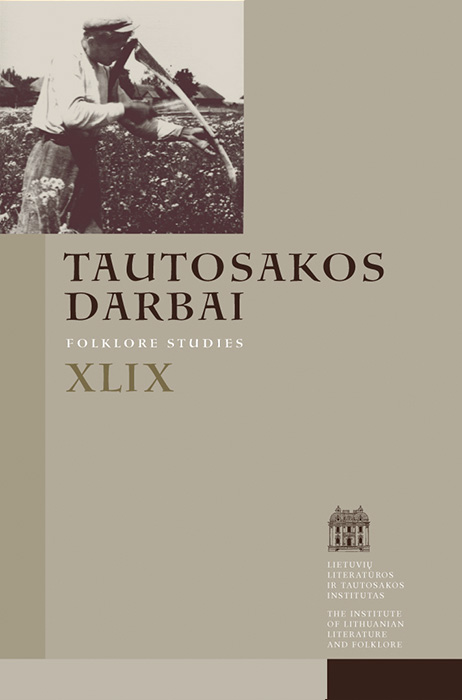Tradicinės kultūros poslinkiai. Dainos XX–XXI a. didmiestyje
Santrauka
Tiriama šiuolaikinė mieste gyvuojanti tradicinė kultūra, aiškinamasi, kaip ji prisitaikė prie naujų sąlygų. Per pastarąjį šimtmetį tradicinė kultūra labai pasikeitė: kitados kaimo bendruomenių saugotą sakytinę tradiciją ėmė puoselėti miesto kultūrinės bendrijos. Tačiau tai nebuvo vien nuolatinė, nežymi kaita – XX a. įvyko keletas ryškių kultūros poslinkių. Straipsnio tikslas – sugretinti urbanistinius, visuomeninius ir kultūros pokyčius ir nustatyti, kuriais laikotarpiais tradicinė kultūra labiausiai transformavosi, atsirado įvairių naujadarų. Tyrime taikomi aprašomasis, lyginamasis ir interpretacinis metodai. Autorės nuomone, XX a. pradžioje, septintajame ir dešimtajame dešimtmečiais įvykę tradicinės kultūros poslinkiai ir ne tokie žymūs pokyčiai lėmė, kad liaudies dainos, anksčiau susijusios su žemdirbystės papročiais, ėmė skambėti miesto šventėse, įvairiuose renginiuose. Šiuolaikiniame didmiestyje jos sklinda iš garsiakalbių bei mirga ekranuose, stebina savitu atlikimu, naujomis interpretacijomis, įspūdžiui sukurti pasitelktomis šiuolaikinėmis technologijomis.
Atsisiuntimai
Skaitomiausi šio autoriaus(ų) straipsniai
- Austė Nakienė, Radvilė Racėnaitė, Vita Ivanauskaitė-Šeibutienė, Rytis Ambrazevičius, Lina Būgienė, Gražina Kadžytė, Rima Visackienė, Irena Žilienė, Andželika Jakubynienė, Kronika , Tautosakos darbai: T 52 (2016)
- Jurga Sadauskienė, Austė Nakienė, Rytis Ambrazevičius, Asta Skujytė-Razmienė, Radvilė Racėnaitė, Gražina Kadžytė, Modesta Liugaitė-Černiauskienė, Vita Džekčioriūtė-Medeišienė, Eligija Garšvienė, Kronika , Tautosakos darbai: T 54 (2017)
- Austė Nakienė, Daiva Vaitkevičienė, Vita Džekčioriūtė-Medeišienė, Gražina Kadžytė, Aurimas Bačiulis, Vida Savoniakaitė, Lina Būgienė, Kronika , Tautosakos darbai: T 55 (2018)
- Austė Nakienė, Romantizmo motyvai partizanų ir tremtinių dainose , Tautosakos darbai: T 61 (2021)
- Greta Paskočiumaitė, Austė Nakienė, Bronė Stundžienė, Jurga Sadauskienė, Kronika , Tautosakos darbai: T 62 (2021)
- Jūratė Šlekonytė, Asta Skujytė-Razmienė, Gražina Kadžytė, Austė Nakienė, Vita Džekčioriūtė-Medeišienė, Kronika , Tautosakos darbai: T 56 (2018)
- Radvilė Racėnaitė, Asta Skujytė-Razmienė, Ainė Skudutytė, Povilas Krikščiūnas, Gaila Kirdienė, Austė Nakienė, Rūta Žarskienė, Kronika , Tautosakos darbai: T 50 (2015)
- Austė Nakienė, Apie tris Baltijos šalis: kaip dainuojanti opozicija virto Dainuojančia revoliucija , Tautosakos darbai: T 48 (2014)
- Austė Nakienė, Beata Baublinksienė, Aušra Žičkienė, Audronė Gedžiūtė, Vita Džekčioriūtė-Medeišienė, Kronika , Tautosakos darbai: T 60 (2020)
- Austė Nakienė, Daiva Račiūnaitė-Vyčinienė, Rokas Sinkevičius, Aušra Žičkienė, Nijolė Laurinkienė, Rūta Žarskienė, Kronika , Tautosakos darbai: T 53 (2017)
